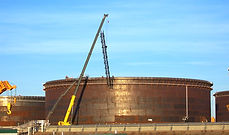WISDOM ENGINEERING
mail: sravani@consultant.com

MUMBAI, , INDIA
Whatsup message or call 24/7 availible
Phone & Whatsup: +91-8374485833,
mail: sravani@consultant.com






Wisdom is one of the leading design Service provider for oil & Gas, Petrochemical & process Industries


As a leading consultant for standard API 650 & other international standards wisdom provider of engineering solutions for bitumen tank design engineering packages; we serve the energy sectors such as oil & gas, petrochemical, EPC manufacturing, Power generation and marine & offshore
"Wisdom is very knowledgeable and giving correct solution for our queries for bitumen tanks"
Nikel-Ass. Manager , Petrofac, Sharjah



1

Design Calculations preparation
Design calculation according to various International codes and standards, strength calculations, wind, seismic , supporting etc--
2

2D CAD drawing services
General Arrangement (GA) drawing and Detail Drawings for fabrication
3

Tender documentation preparation
-
Cost Estimation for tenders.
-
Pre bid documents preparation.
-
post bid documents preparation
4
Basic Design & FEED
-
FEED front end design engineering.
-
Basic design engineering, sizing
5
Vender Documents
-
Mechanical datasheets preparation.
-
vendor documents review.
-
Technical bid evolution
6
Tank foundation
-
Tank foundation design and drawings
Design services for a bitumen storage tank
in the 20 tons to 50 tons capacity
Design of bitumen storage tank in the 20m³ to 50m³ range with specific requirements, such as self-supported cone roofs, compliance with API 650 standards, and integrated features like insulation, heating systems, and overfill protection, involves several detailed calculations, design steps, and drafting. Below is an outline for addressing these key components:
Design Calculations
For self-supported cone roof tanks designed according to API 650, several key calculations are required to ensure structural integrity and safety.
General Arrangement (GA) Drawing
A General Arrangement (GA) Drawing for self-supported cone roof tanks typically includes detailed information about the tank's layout, dimensions, and components. Here are some key details that are usually included:
-
Tank Dimensions: Overall height, diameter, and wall thickness.
-
Roof Design: Slope, height, and details of the cone roof structure.
-
Nozzles and Openings: Locations and dimensions of manholes, vents, and other openings.
-
Support Structures: Details of any support structures, such as wind girders or stiffening rings.
-
Access Platforms: Locations and dimensions of access ladders, platforms, and handrails.
-
Instrumentation: Positions and details of gauges, level indicators, and other instrumentation.
-
Welding Details: Specifications for welds, including locations and types of welds.
-
Material Specifications: Types of materials used for different parts of the tank.
"Right from our initial consultation to WIDOM, it was evident that this company truly values their clients and their unique needs. The team took the time to thoroughly understand my project requirements, listening attentively to my ideas and concerns. They asked relevant questions and provided valuable insights, showcasing their extensive knowledge and experience in the field of Bituman tank design."
Muntaj, Sr. Procurement Engineer ,
DOW CHEMICALS, Mumbai

Design services for a bitumen storage tank
in the 100 tons capacity
Designing and fabricating a bitumen storage tank in the 100m³ to 1000m³ range with specific requirements, such as supported cone roofs, column supported roofs, truss supported roofs compliance with API 650 standards, and integrated features like insulation, heating systems, and overfill protection, involves several detailed calculations, design steps, and drafting. Below is an outline for addressing these key components:
Design Services for a Bitumen Storage tank
in the Over 100 m³ Capacity
Designing and fabricating a bitumen storage tank in the over 1000m³ range with specific requirements, such as supported cone roofs, column supported roofs, truss supported roofs compliance with API 650 standards, and integrated features like insulation, heating systems, and overfill protection, involves several detailed calculations, design steps, and drafting. Below is an outline for addressing these key components:
BITUMEN STORAGE Horizontal Bitumen
Storage tank design services
-
Capacities of 30 - 100 tonnes
-
Range of heating options available
-
Thermostatically controlled temperature
-
Accurate continuous level indication
-
High density insulation and robust external finish
-
Independent ultimate high level alarm
-
Easy to operate & requires minimal maintenance
-
Ideal for sites with height restrictions
-
Rapid on site set up times/ pre wired and tested.
" Wisdom Highly collaborative and great teamwork. Qualities and accuracy of work are excellent. Reliability and communication are good."
Nani, Design Engineer. , Haldia, Kolkata




Bitumen plays an indispensable role in road construction and infrastructure development across the globe. As the demand for more efficiency and sustainable construction materials increases, the industry is turning toward innovative solutions in bitumen storage
Optimal Storage Temperature
-
Typical Range: Bitumen is typically stored at temperatures ranging from 150°C to 180°C (302°F to 356°F). This range ensures that the bitumen remains in a liquid or semi-liquid state, making it easy to handle, transport, and apply. At this temperature, bitumen has the right viscosity for mixing with aggregates and other materials in road construction.
Insulation and Temperature Control
-
Insulated Storage Tanks: To maintain the required temperature and prevent heat loss, bitumen storage tanks are often insulated. This reduces the energy required to maintain the temperature, improving efficiency and reducing costs.
Heat Tracing Systems:
Some storage facilities also use heat tracing systems, where electrical heating cables are wrapped around the tanks to maintain a constant temperature. These systems help ensure bitumen remains at the ideal temperature, even in colder environment
Designing and fabricating a bitumen storage tank in the 20m³ to 50m³ range with specific requirements, such as self-supported cone roofs, compliance with API 650 standards, and integrated features like insulation, heating systems, and overfill protection, involves several detailed calculations, design steps, and drafting. Below is an outline for addressing these key components:
Design Calculations
For self-supported cone roof tanks designed according to API 650, several key calculations are required to ensure structural integrity and safety.
General Arrangement (GA) Drawing
A General Arrangement (GA) Drawing for self-supported cone roof tanks typically includes detailed information about the tank's layout, dimensions, and components. Here are some key details that are usually included:
-
Tank Dimensions: Overall height, diameter, and wall thickness.
-
Roof Design: Slope, height, and details of the cone roof structure.
-
Nozzles and Openings: Locations and dimensions of manholes, vents, and other openings.
-
Support Structures: Details of any support structures, such as wind girders or stiffening rings.
-
Access Platforms: Locations and dimensions of access ladders, platforms, and handrails.
-
Instrumentation: Positions and details of gauges, level indicators, and other instrumentation.
-
Welding Details: Specifications for welds, including locations and types of welds.
-
Material Specifications: Types of materials used for different parts of the tank.
Detail Fabrication Drawings
Fabrication drawings provide the detailed construction and assembly instructions. These should include:
-
Material Specifications: Type of steel (typically carbon steel or stainless steel), thickness of shell plates, roof plates, and insulation materials.
-
Welding Details: Types of welds to be used for the tank, ensuring the strength and leak-proof properties.
-
Roof Support Details: Design of the roof, including reinforcement details, plate thicknesses, and weld types.
-
Dimensions: Specific measurements for all parts, including shell height, diameter, roof slope, nozzle sizes, and tank access points.
-
Tank Base: Design of the tank foundation, usually a concrete slab, with reinforcement for stability.
-
Pressure Relief/Overfill Protection: Detailed design of the overfill prevention systems, such as high-level alarms, automatic shut-off valves, and pressure relief valves.
-
These drawings to be provided in standard CAD formats, like DWG and PDF, to clearly show the assembly process and final tank configuration.








